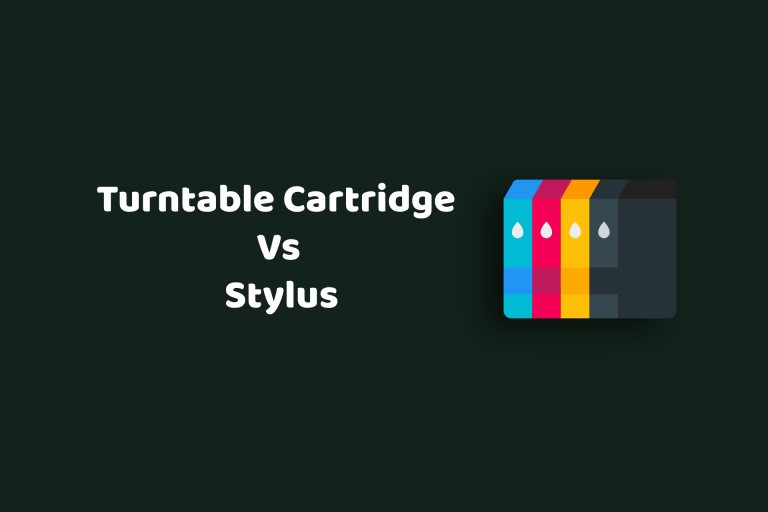When to Replace Turntable Stylus?
Your turntable’s stylus is a small yet essential component that directly impacts sound quality and protects your vinyl records. Over time, it wears down, leading to poor audio and potential damage to your collection.
Knowing when to replace it is crucial to maintaining the best listening experience. In this guide, we’ll explore the key signs of a worn stylus, how long it typically lasts, and practical tips to keep your records and turntable in top shape.
Let’s get started!
What is a Turntable Stylus?
The turntable stylus—often called the “needle”—is the tiny yet mighty part of your turntable responsible for reading the grooves on a vinyl record. Without a properly functioning stylus, even the best vinyl won’t sound right.
Here’s how it works: when you play a record, the stylus sits in the grooves, tracing every peak and valley. This movement generates vibrations, which are then transformed into an electrical signal by the cartridge and amplified into the music you hear.
Types of Styluses
A stylus is usually made from diamond or sapphire, chosen for their durability. These materials are shaped into a fine point to fit snugly into the grooves of your record. Depending on its shape, a stylus can be:
- Conical: The most basic and budget-friendly design.
- Elliptical: Offers better groove contact for more detailed sound.
- MicroLine: The premium option, delivering the best sound reproduction and groove tracking.
Why Do You Need to Replace a Stylus?
Here’s why replacing your stylus is so important:
1. Protect Your Vinyl Collection
Your records are delicate, with grooves that store all the tiny details of your music. A worn or damaged stylus can’t properly track these grooves. Instead, it might scrape or scratch them, causing permanent damage. Think about it: a single bad stylus could ruin your favorite album forever.
2. Maintain Sound Quality
Ever notice distortion, muffled audio, or annoying crackles when you play a record? That’s often your stylus crying out for help. A worn stylus struggles to track the grooves accurately, which means you lose the detail and clarity that make vinyl special.
3. Prevent Damage to Your Turntable
It’s not just your records that can suffer from a bad stylus. A worn stylus can also strain your turntable’s tonearm and cartridge, leading to additional wear and tear.
Signs That It’s Time to Replace Your Stylus
Not sure if your stylus needs replacing? Don’t worry—you’re not alone. Many of us tend to overlook the signs until it’s too late. Let’s break down the signs you need to watch for:
1. Your Records Start Skipping
Have you noticed your records skipping more than usual, even when they’re clean? That’s a classic red flag. A worn stylus can no longer track the grooves properly, causing it to jump across the record.
2. Distorted or Fuzzy Sound
You know the warm, clear sound vinyl is known for? If that’s been replaced by distortion, muffled audio, or a general lack of detail, your stylus could be to blame. For example:
- Vocals may sound scratchy or thin.
- Instruments lose their depth and richness.
- Static and crackling noises become more frequent.
3. Excessive Sibilance
Sibilance is when “sss” sounds in vocals become sharp and overemphasized. If your records suddenly sound like a hissy mess, your stylus may be too worn to track the grooves correctly.
Pro Tip: Before replacing your stylus, make sure the issue isn’t caused by misalignment or incorrect tracking force. If those are fine, the stylus is likely at fault.
4. Physical Damage
Sometimes, the signs are visible. Inspect your stylus under good lighting or with a magnifying glass. Look for:
- A flattened or chipped tip.
- A bent cantilever (the tiny arm holding the stylus).
- Black residue on the stylus that doesn’t come off with cleaning.
5. Increased Surface Noise
Surface noise, like crackles and pops, is normal to some extent with vinyl. But if you notice a sudden increase in noise that wasn’t there before, it might mean your stylus isn’t tracking the grooves properly.
6. Skipping on Inner Grooves (Inner Groove Distortion)
Inner groove distortion happens when the stylus struggles to track the tighter grooves near the end of a record. If this issue starts cropping up more frequently, it’s likely time for a replacement.
7. Cartridge Feels Loose or Wobbly
Sometimes, a worn stylus can cause the cartridge to wobble or feel less secure. This affects the stylus’s ability to track grooves accurately, leading to inconsistent playback.
How Long Does a Stylus Last?
Styluses aren’t designed to last forever. On average:
- A diamond stylus lasts 800–1,000 hours of playback.
- Sapphire styluses have a shorter lifespan, around 300–500 hours.
- Cheaper materials may wear out even faster.
How often you spin your records plays a big role in how long your stylus lasts. Let’s do the math:
- 1 hour per day: A diamond stylus will last about 2–3 years.
- 3 hours per day: You’ll need a new stylus in 1 year or less.
- Occasional use: If you’re an occasional listener, your stylus may last closer to the upper limit.
But remember, even if you use your turntable sparingly, age and wear can still degrade the stylus.
Factors That Can Shorten Stylus Life
Unfortunately, some habits and conditions can wear down your stylus faster than normal. Here’s what to watch out for:
- Dirty Records: Playing dusty or dirty vinyl puts extra strain on the stylus, reducing its lifespan.
Tip: Clean your records regularly with an anti-static brush or a record-cleaning solution.
- Poor Setup: Misalignment or incorrect tracking force can cause uneven wear.
Tip: Use a tracking force gauge to ensure the tonearm is properly calibrated.
- Cheap Records or Pressings: Lower-quality vinyl with uneven grooves can accelerate wear.
- Environmental Factors: Dusty or humid environments can clog the stylus or cause corrosion.
How to Extend Your Stylus Life?
A little care goes a long way in making your stylus last. Here’s what you can do:
- Keep your records clean: Dust and dirt are your stylus’s worst enemies.
- Store your turntable properly: Cover it when not in use to prevent dust buildup.
- Align and balance your tonearm: Misalignment causes uneven wear and can shorten the lifespan.
- Replace on time: Don’t wait for major issues—stick to the recommended hours for replacement.
How to Replace Your Turntable Stylus?
Replacing a turntable stylus might sound intimidating, but trust me, it’s simpler than you think. This step-by-step guide will walk you through the process:
1. Check Compatibility
Identify your turntable model and cartridge type to ensure you buy the right stylus. Refer to your user manual or the manufacturer’s website for details.
2. Gather Tools
Prepare a clean, flat workspace and, if needed, a magnifying glass or tweezers for precision.
3. Remove the Old Stylus
- Turn off the turntable: Unplug it to avoid damage.
- Detach carefully: Gently pull the old stylus downward. Avoid touching the cantilever.
4. Install the New Stylus
- Align it with the cartridge and slide it into place until secure.
- Check alignment using a stylus protractor, if necessary.
5. Test and Maintain
- Test with a less valuable record for clear, smooth playback.
- Clean the stylus regularly and store your turntable covered to extend its lifespan.
Time for a New Stylus? Keep Your Vinyl Sounding Great!
Your stylus might be small, but it’s the heart of your turntable setup. Replacing it on time ensures your music stays crisp and your records stay safe.
By spotting the signs, understanding its lifespan, and handling replacements carefully, you can enjoy a flawless vinyl experience for years.
So, don’t wait—give your turntable the love it deserves and keep those records spinning at their best!
Frequently Asked Questions
How do I know if my stylus needs replacing if I don’t hear issues?
Even without audible issues, styluses wear out over time. Check the playback hours (800–1,000 for diamond styluses) or inspect the tip under a magnifying glass for flattening or damage. Regular replacement prevents record damage.
Can I repair a worn stylus instead of replacing it?
No, a worn stylus cannot be repaired. Once damaged or worn, it needs to be replaced to maintain sound quality and protect your records.
What’s the difference between replacing the stylus and the cartridge?
The stylus is the needle that tracks grooves; it’s replaceable. The cartridge houses the stylus and converts vibrations into sound signals. Replace the cartridge only if it’s faulty or for an upgrade.





